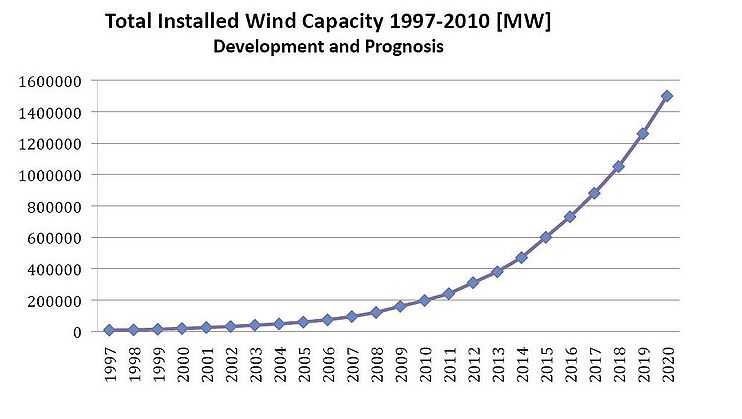Click here to register!
Difference between revisions of "Wind Energy - Introduction"
***** (***** | *****) |
***** (***** | *****) |
||
| Line 28: | Line 28: | ||
(Source: http://www.wwindea.org/technology/ch02/en/2_7_1.html) <br><br> | (Source: http://www.wwindea.org/technology/ch02/en/2_7_1.html) <br><br> | ||
| − | == | + | == Potentials == |
| − | [[Image:Forecast wind capacity 2020.JPG|center|742x430px|Forecast wind capacity 2020.JPG]] Source: WWEA 2011: World Wind Energy Report 2010. Bonn, p. 18 | + | Expected future growth Global Wind Capacity:<br> |
| + | |||
| + | [[Image:Forecast wind capacity 2020.JPG|center|742x430px|Forecast wind capacity 2020.JPG]] Source: WWEA 2011: World Wind Energy Report 2010. Bonn, p. 18 <br> | ||
[[Category:Wind]] | [[Category:Wind]] | ||
Revision as of 06:34, 26 April 2011
Introduction
Many developing countries and emerging economies have substantial unexploited wind energy potential. In many locations, generating electricity from wind energy offers a cost-effective alternative to thermal power stations. It has a lower impact on the environment and climate, reduces dependence on fossil fuel imports and increases security of supply.
For many years now, developing countries and emerging economies have been faced with the challenge of meeting additional energy needs for their social and economic development with obsolete energy supply structures. Overcoming supply bottlenecks through the use of fossil fuels in the form of coal, oil and gas increases dependency on volatile markets and eats into valuable foreign currency reserves. At the same time there is growing pressure on emerging newly industrialised countries in particular to make a contribution to combating climate change and limit their pollutant emissions.
In the scenario of alternatives, more and more developing countries and emerging economies are placing their faith in greater use of renewable energy and are formulating specific expansion targets for a ‘green energy mix’. Wind power, after having been tested
for years in industrialised countries and achieving market maturity, has a prominent role to play here. In many locations excellent wind conditions promise inexpensive power generation when compared with costly imported energy sources such as diesel.
Despite political will and considerable potential, however, market development in these countries was relatively slow to take off. There was a shortage of qualified personnel to establish the foundations for the exploitation of wind energy and to develop projects
on their own initiative. The absence of reliable data on wind potential combined with unattractive energy policy framework conditions deterred experienced international investors, who instead focused their attention on the expanding markets in Western countries.
It is only in recent years that appreciable development of the market potential in developing countries and emerging economies has taken place. The share of global wind generating capacity accounted for by Africa, Asia and Latin America reached about 20%
at the end of 2008, with an installed capacity of 26 GW. This is attributable above all to breathtaking growth in India and China: these two countries alone are responsible for 22 GW. This proves that economic use of wind energy in developing countries and emerging economies is possible, and also indicates that there is immense potential that is still unexploited.
Facts about Wind Energy
Wind Energy for Development
"The wind energy potential in many developing and emerging countries is substantial. In many locations, generating electricity from wind energy presents an economically viable alternative to the use of conventional fossil energy sources such as coal or diesel. In developing and emerging countries, wind turbines are an alternative to conventional power stations. In comparison to fossil-fuelled power stations, wind energy can now be cost-effective in many places, as well as being non-polluting and reducing dependence on imports of fossil fuels.(...)
Despite the economic and ecological advantages, so far even good wind resources in developing and emerging countries have not been used to the desirable extent.
The essential reasons for this are based in the lack of knowledge in the developing and emerging countries. From the view of international wind energy companies, beside the difficulties of raising of capital and risk covering, the barriers for private investment are especially:
- lack of information on foreign markets
- lack of knowledge of the energy-sector framework conditions and support mechanisms
- insufficient wind energy legal framework (technical and economical conditions for feeding wind-generated electricity into power grids, permit procedure, ...)
- lack of qualified staff, especially in the field of service/maintenance"
(Source: http://www.wwindea.org/technology/ch02/en/2_7_1.html)
Potentials
Expected future growth Global Wind Capacity:
Source: WWEA 2011: World Wind Energy Report 2010. Bonn, p. 18




















